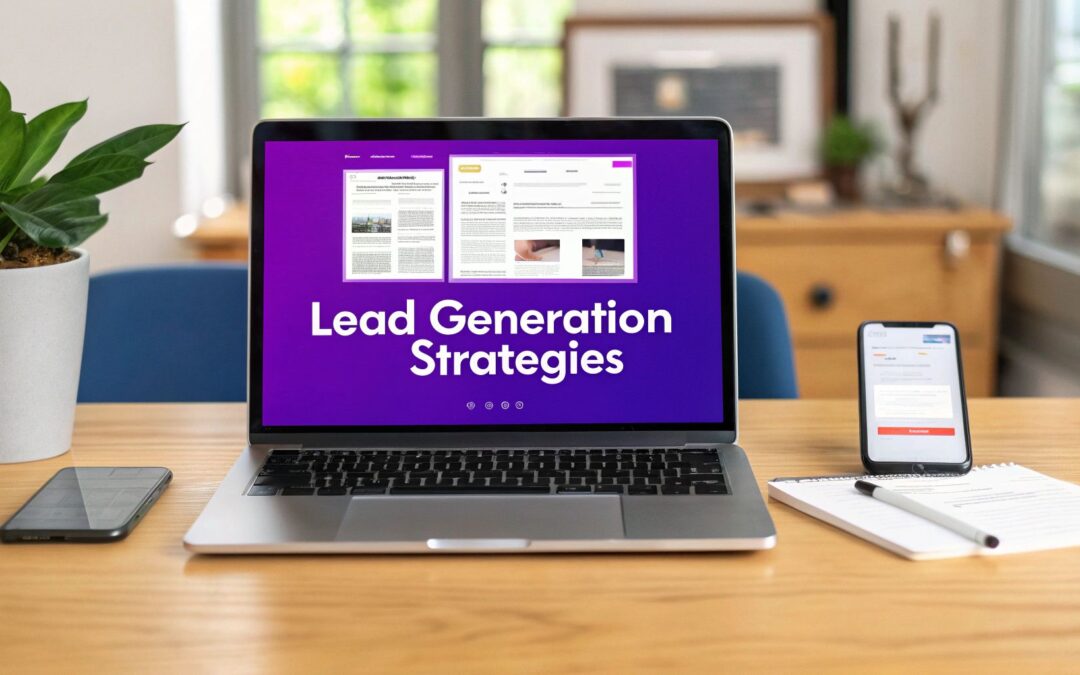Your website is more than a digital brochure; it's your most powerful asset for attracting and converting new customers. But simply having a beautiful site isn't enough. To achieve sustainable growth, you need to implement effective website lead generation strategies that turn passive visitors into engaged prospects. Many businesses struggle with this, seeing traffic come and go without capturing any value. The key is to strategically engage visitors at the right moment with the right offer.
In this guide, we'll break down 10 proven strategies, from dynamic popups to smart content offers, that you can implement to build a predictable pipeline of qualified leads. Structuring these efforts is crucial. For a deeper dive into structuring your approach, understanding the components of an effective B2B lead generation funnel can provide a comprehensive strategic overview.
We'll explore how tools like Divimode's Divi Areas Pro can simplify the process, allowing you to create sophisticated, high-converting experiences with features like exit-intent triggers, advanced targeting rules, and seamless content injection. These tactics will transform your Divi website into a true conversion engine, helping you build a consistent and reliable flow of new business opportunities.
1. Master High-Value Lead Magnets and Content Offers
The foundation of many successful website lead generation strategies is the value exchange. A high-value lead magnet is a specific resource, like an ebook, checklist, or exclusive guide, that you offer visitors in exchange for their contact information. This isn't just about giving away freebies; it’s a strategic approach to provide a targeted solution to a specific problem your audience faces.
A well-crafted lead magnet instantly positions you as an authority and initiates a relationship built on trust and value. The goal is to create content so indispensable that your ideal customer is happy to provide their email to access it. For Divi users, this process is streamlined with a plugin like Divi Areas Pro. You can create a dedicated 'Area' containing your opt-in form and trigger it as a popup when a user shows interest, making your offer both timely and relevant.

Actionable Tips for Implementation
- Solve a Specific Pain Point: Create content that directly addresses a narrow, urgent problem. Instead of a "Guide to Marketing," offer a "7-Day Checklist for Launching Your First Google Ad Campaign."
- Use Compelling, Benefit-Focused Copy: Your headline and call-to-action should clearly state the tangible benefit the user will receive. For example, "Download the Template to Save 5 Hours on Weekly Reporting."
- Keep Forms Simple: Minimize friction by asking only for essential information. An email address is often enough to start. You can gather more data later in the customer journey.
- Ensure Immediate Delivery: Automate your email system to send the promised resource the moment a user subscribes. This immediate fulfillment builds credibility.
2. Leverage Exit-Intent Popups to Recapture Attention
One of the most effective website lead generation strategies involves catching visitors right before they leave. Exit-intent popups are overlays triggered by a user's mouse movement toward the browser's exit button, close icon, or back button. This technology presents a final, compelling offer to recapture their interest and convert abandoning traffic into valuable leads.
This last-chance appeal interrupts a user's departure with a targeted message, turning a potential lost opportunity into a conversion. For example, an e-commerce store can offer a 15% discount code, while a SaaS business might present a last-minute invitation to a free trial or demo. With a tool like Divi Areas Pro, you can configure a popup Area to display exclusively to users showing exit intent, making your intervention perfectly timed and highly relevant.

Actionable Tips for Implementation
- Make an Irresistible Offer: The value proposition must be strong enough to halt a user's exit. Think significant discounts, exclusive content, or a free, high-value tool.
- Use Strong, Urgent Copy: Create a sense of urgency or scarcity. Phrases like "Wait! Get 20% Off Before You Go" or "Claim Your Free Guide Now" are highly effective.
- Keep the Design Clean and Focused: The popup should have a single, clear call-to-action. Avoid cluttering it with too much text or multiple choices that could cause confusion.
- A/B Test Your Messaging: Continuously test different headlines, offers, and visuals to identify what resonates most with your audience and maximizes conversions.
3. Live Chat and Chatbots
Integrating live chat and automated chatbots is one of the most direct website lead generation strategies, transforming your site from a static brochure into a dynamic conversation hub. This approach offers immediate, real-time engagement, allowing visitors to get answers, receive support, and interact with your business the moment a question arises. It effectively shortens the sales cycle by addressing potential objections instantly.
Platforms like Drift and Intercom have pioneered this conversational marketing model, where interactions feel personal and immediate. Instead of forcing a potential lead to fill out a form and wait, you can qualify them, book demos, and guide them toward a solution on the spot. This proactive engagement makes visitors feel valued and supported, significantly boosting conversion rates and customer satisfaction. For Divi users, many chat plugins integrate seamlessly, allowing you to embed a chat widget with just a few clicks.

Actionable Tips for Implementation
- Use Proactive Chat Triggers: Set up chat invitations based on user behavior. For instance, trigger a chat window if a visitor spends more than 30 seconds on your pricing page or views multiple product pages.
- Create Chatbot Triage Flows: Design automated chatbot sequences to handle common questions like "What are your hours?" or "Where is my order?" This frees up your human agents to focus on high-intent, sales-ready leads.
- Train Staff on Lead Qualification: Equip your live chat team with a clear set of questions to identify and qualify potential leads effectively. Define what constitutes a Marketing Qualified Lead (MQL) versus a Sales Qualified Lead (SQL).
- Integrate with Your CRM: Connect your chat tool directly to your CRM (like HubSpot or Salesforce) to automatically create new contacts, log chat transcripts, and ensure seamless follow-up from your sales team.
4. Landing Page Optimization
A crucial component of effective website lead generation strategies involves optimizing dedicated landing pages. Unlike a regular homepage with multiple navigation options, a landing page is a standalone web page created specifically for a marketing or advertising campaign. Its sole purpose is to convert visitors into leads by focusing on a single, clear call-to-action with minimal distractions. This laser-focused approach dramatically increases the likelihood of a visitor taking the desired action, such as signing up for a webinar or downloading a case study.
By directing traffic from a specific source, like a Google Ad or an email newsletter, to a page that mirrors the ad's messaging and promise, you create a seamless and persuasive user journey. Platforms like Unbounce and Leadpages have built their businesses on this principle, demonstrating that well-crafted landing pages consistently outperform generic website pages for conversions. A powerful landing page is a direct, uncluttered path from visitor interest to lead capture.

Actionable Tips for Implementation
- Match Message to Medium: Ensure your landing page headline and content directly reflect the promise made in the ad or link that brought the user there. This "message match" builds trust and reduces bounce rates.
- Use a Clear, Benefit-Oriented Headline: Immediately answer the visitor's question: "What's in it for me?" Focus on the value they will receive, not just the features of your offer.
- Leverage Social Proof and Trust Signals: Include testimonials, customer logos, case study snippets, or security badges to build credibility and reassure visitors that they are making a safe and valuable choice.
- Keep Forms Simple: Only ask for the information you absolutely need. Every additional field you add increases friction and can lower your conversion rate. An email address is often enough to start the conversation. For more insights, you can learn how to create the perfect landing page on divimode.com.
5. Content Marketing and SEO
Content marketing and SEO are a powerhouse duo for sustainable, long-term website lead generation strategies. This approach focuses on creating high-quality, valuable content that is optimized to rank in search engines. By attracting organic traffic from users actively searching for solutions, you draw in highly qualified prospects who are already interested in your area of expertise.
Instead of interrupting users with ads, you pull them in by providing the answers they need through blog posts, in-depth guides, or case studies. This strategy builds authority and trust, making visitors more likely to convert. For instance, a well-optimized blog post can attract a visitor, and with a tool like Divi MadMenu, you can feature a prominent CTA in your navigation menu, guiding them directly to a relevant service or product page, capturing the lead at their peak moment of interest.
Actionable Tips for Implementation
- Target Search Intent: Research what your audience is actually searching for. Create content that directly answers their questions and solves their problems, aligning with user intent.
- Build Topic Clusters: Develop a main "pillar" page for a broad topic and surround it with "cluster" content that covers specific subtopics in detail. This signals expertise to search engines.
- Optimize for On-Page SEO: Ensure every piece of content includes relevant keywords, compelling meta descriptions, optimized images, and a clear, logical structure with headings.
- Use Internal Linking Strategically: Guide users and search engine crawlers through your site by linking from your informational content to your high-converting product or service pages.
6. Social Proof and Testimonials
Effective website lead generation strategies often rely on a powerful psychological trigger: social proof. This principle suggests that people look to the actions and experiences of others to guide their own decisions. By strategically showcasing customer testimonials, reviews, case studies, and trust logos on your site, you build instant credibility and reduce the perceived risk of engaging with your brand.
Integrating social proof validates your claims and shows potential leads that real people have found success with your offerings. Instead of just telling visitors your product is great, you let satisfied customers do the selling for you. This builds a layer of trust that is difficult to achieve with marketing copy alone, making visitors more comfortable sharing their contact information. For instance, displaying a compelling review right next to a sign-up form can significantly boost conversion rates.
Actionable Tips for Implementation
- Be Specific and Results-Oriented: Vague praise like "great service" is less effective than a testimonial detailing a tangible outcome, such as "Their service helped us increase our organic traffic by 45% in three months."
- Include Photos and Real Names: Attaching a face and a full name (with permission) to a testimonial makes it more authentic and relatable, enhancing its credibility.
- Display Proof Near Conversion Points: Place your strongest testimonials, trust badges, or customer logos directly beside CTAs, on pricing pages, or within checkout forms to overcome last-minute hesitation.
- Leverage Video for Higher Impact: Video testimonials are highly engaging and can convey emotion and sincerity more effectively than text. A short, genuine video can be one of your most persuasive assets. Explore some of the best WordPress testimonial plugins to implement this effectively.
7. Email Newsletter Signup Forms
Among the most timeless website lead generation strategies is the classic email newsletter signup form. Instead of offering a one-time resource, a newsletter promises ongoing value, turning casual visitors into a loyal audience. Strategically placing these forms in your website’s header, footer, sidebar, or within blog posts keeps the invitation to connect constantly visible.
This method builds a direct line of communication with your audience, allowing you to nurture leads over time with valuable content, updates, and offers. By consistently delivering high-quality content, as seen with massive newsletters like The Hustle or Morning Brew, you establish authority and keep your brand top-of-mind. This approach turns your website from a static brochure into a dynamic community-building tool.
Actionable Tips for Implementation
- Communicate the Value Proposition: Clearly state what subscribers will get. Instead of "Subscribe to our newsletter," try "Get weekly e-commerce tips to boost your sales."
- Set Clear Expectations: Tell users how often you will email them (e.g., daily, weekly, monthly). This transparency builds trust and manages expectations.
- A/B Test Form Placement: Experiment with different locations for your signup forms. A form in the footer might perform differently than one embedded after a blog post. Test to see what converts best for your audience.
- Use a Double Opt-in: While it adds an extra step, requiring users to confirm their subscription via email ensures a higher-quality, more engaged list and improves deliverability. You can learn more about how to create a lead generation page using Divi's Contact Form module to get started.
8. Webinars and Virtual Events
Hosting webinars or virtual events is one of the most effective website lead generation strategies for engaging a captive audience with high-value, long-form content. These live or pre-recorded online seminars allow you to present expert knowledge, demonstrate a product, or host a Q&A session, all while collecting registration details from highly interested prospects. The format positions your brand as an industry leader and builds a direct, personal connection with attendees.
A successful webinar creates a sense of community and provides an interactive platform for education. By offering exclusive insights into a topic your audience cares about, like HubSpot does with its marketing series, you create a compelling reason for them to share their contact information. The value exchange is clear: deep expertise for an email address, establishing a strong foundation for future marketing efforts. This strategy is perfect for complex B2B services or high-ticket products where education is a key part of the sales cycle.
Actionable Tips for Implementation
- Choose a Problem-Solving Topic: Select a subject that tackles a specific, urgent pain point for your audience. Instead of "An Intro to SEO," offer "How to Conduct a Technical SEO Audit in Under 60 Minutes."
- Promote Extensively: Use all available channels to drive registrations. Announce the event on your website's header, in your newsletter, across social media, and through partner collaborations.
- Include Interactive Elements: Keep your audience engaged with live polls, Q&A segments, and interactive chat. This prevents passive viewing and makes the experience more memorable and valuable.
- Follow Up Promptly: Send a thank-you email to all attendees within 24 hours, including a link to the recording and any resources mentioned. This reinforces your message and opens the door for the next step.
- Repurpose the Recording: Turn your webinar into an evergreen lead magnet. Gate the recording on a landing page so it continues to generate leads long after the live event has ended.
9. Progressive Profiling and Smart Forms
Asking for a dozen details on a first-time signup form is a surefire way to kill conversion rates. Progressive profiling is one of the most intelligent website lead generation strategies because it collects information incrementally. Instead of a single, intimidating form, you use smart forms that adapt over time, asking for new information on each subsequent visit. This technique respects the user's time while systematically building a rich, detailed lead profile.
This approach transforms lead generation from a one-time transaction into an ongoing conversation. The first time a user downloads a checklist, you might only ask for their email. When they return to access a webinar, the form will recognize them and ask for their company name and size. This gradual data collection feels natural, reduces friction, and provides you with the high-quality data needed for effective lead segmentation and personalization. Platforms like HubSpot and Marketo have championed this method, proving its power in nurturing leads effectively.
Actionable Tips for Implementation
- Start with the Essentials: On the initial conversion, only ask for critical information, such as an email address and first name. This minimizes the barrier to entry.
- Use Conditional Logic: Configure your forms to show new fields only to returning visitors. If you already have their company name, ask for their job title or a specific challenge they face next.
- Provide Value at Each Stage: Ensure that every request for more information is paired with another high-value content offer. The user should always feel they are getting something worthwhile in the exchange.
- Map Out Your Question Sequence: Plan the data points you need and the logical order in which to ask for them. Start with general information and move toward more specific, qualifying questions over 2-3 interactions.
10. Retargeting and Pixel-Based Lead Recovery
Not every visitor will convert on their first visit, and that’s where retargeting comes in as one of the most powerful website lead generation strategies. By placing a tracking pixel on your site (from platforms like Google or Facebook), you can identify users who visited but didn't convert. You can then serve them targeted ads on other websites and social media, reminding them of your value and encouraging them to return.
This approach keeps your brand top-of-mind and gives you a second chance to capture leads that would otherwise be lost. It's a highly efficient way to re-engage warm traffic, as these users have already shown interest in what you offer. For instance, a user who viewed your pricing page but didn’t sign up could be shown an ad with a special introductory offer, compelling them to come back and complete the process.
Actionable Tips for Implementation
- Segment Your Audiences: Don’t treat all visitors the same. Create separate retargeting audiences based on specific actions, such as visiting a particular service page, abandoning a cart, or spending a certain amount of time on your blog.
- Create Tailored Ad Creatives: Design ads that speak directly to the visitor's previous interaction. If they viewed a specific product, show them an ad for that exact product.
- Use Frequency Caps: To avoid annoying your audience, set a frequency cap on your ads. This limits the number of times a single user sees your ad within a given period, preventing ad fatigue.
- Exclude Recent Converters: Make sure to exclude users who have already converted (e.g., filled out a form or made a purchase) from your campaigns. This saves your budget and prevents a poor user experience.
Lead Generation Strategies Comparison Table
| Item | Implementation Complexity 🔄 | Resource Requirements ⚡ | Expected Outcomes 📊 | Ideal Use Cases 💡 | Key Advantages ⭐ |
|---|---|---|---|---|---|
| Lead Magnets and Content Offers | Moderate – Requires upfront content creation | Medium – Content creation, integration | High – Qualified leads, measurable conversions | Lead capture, list building, brand authority | Value exchange, automation, targeted content |
| Exit-Intent Popups | Low – Easy to implement with available tools | Low – Setup and design | Moderate – Recovers abandoning visitors | Recovering leaving traffic, last-chance offers | Non-intrusive until exit, higher popup conversions |
| Live Chat and Chatbots | High – Setup, training, AI integration needed | High – Staff and technology investment | High – Real-time engagement, lead qualification | Instant support, lead qualification, demos | 24/7 availability, personalized user interaction |
| Landing Page Optimization | Moderate – Requires design and technical skills | Medium – Design and testing | High – Increased conversions, better attribution | Campaign-specific conversions | Focused CTAs, easy A/B testing, improved UX |
| Content Marketing and SEO | High – Consistent, ongoing efforts required | Medium – Content creation and SEO tools | Long-term – Organic traffic growth and authority | Brand building, organic lead generation | Cost-effective, compounding traffic |
| Social Proof and Testimonials | Low – Collecting and displaying content | Low – Content gathering and updating | Moderate – Builds trust and reduces hesitation | Credibility enhancement, conversion support | Authentic validation, easy implementation |
| Email Newsletter Signup Forms | Low – Simple form setup and placement | Low – Integration and design | Moderate – List growth, ongoing engagement | Nurture campaigns, audience building | Cost-effective, personalized follow-up |
| Webinars and Virtual Events | High – Planning and technology management | High – Preparation, hosting, and promotion | High – Strong relationships and higher conversions | Thought leadership, education, product demos | Live engagement, repurpose content |
| Progressive Profiling and Smart Forms | High – Advanced automation and form logic | Medium to High – Marketing automation | High – Better lead profiles, reduced abandonment | Detailed lead data collection over time | User-friendly, improves segmentation |
| Retargeting and Pixel-Based Lead Recovery | Moderate – Setup of tracking and ads | Medium to High – Continuous ad spend | Moderate to High – Recover lost visitors, boost conversions | Brand recall, re-engaging interested visitors | Personalized messaging, cost-effective retargeting |
Start Implementing Your Winning Strategy Today
We've explored a comprehensive array of powerful website lead generation strategies, moving far beyond generic advice to provide a blueprint for tangible growth. From the magnetic pull of well-crafted lead magnets and the last-chance appeal of exit-intent popups to the long-term authority built through content marketing and SEO, it's clear that success isn't about a single tactic. Instead, it's about creating a cohesive, multi-layered system where each element supports the others.
The journey to a high-converting website begins with understanding your audience and their needs. Strategies like progressive profiling and dynamic content injection allow you to treat visitors not as anonymous clicks, but as individuals with unique interests. By tailoring your approach, you transform a one-way broadcast into a two-way conversation, building trust and encouraging action. Remember, even a small improvement in conversion rates can have a massive impact on your bottom line.
Key Takeaways for Immediate Action
The most effective approach is to avoid becoming overwhelmed. Don't try to implement all ten strategies at once. Instead, identify the low-hanging fruit for your specific business.
- Start with Your Foundation: Is your landing page copy clear and compelling? Do you have a simple, visible newsletter signup form? Mastering these fundamentals provides a solid base for more advanced tactics.
- Capture Low-Hanging Fruit: Implementing exit-intent popups with a compelling offer is often one of the quickest ways to see an immediate lift in leads. You're engaging visitors at the exact moment they're about to leave, giving you a final opportunity to provide value.
- Measure, Analyze, and Iterate: The true power of these website lead generation strategies is unlocked through data. Use analytics to track which popups, content offers, and calls to action are performing best. Test different headlines, images, and offers to continuously refine your approach. A strategy that is merely "set and forget" is a strategy destined to underperform.
Ultimately, building a robust lead generation engine is an ongoing process of strategic implementation and data-driven refinement. The tools and techniques discussed provide the framework, but your commitment to testing and optimization is what will turn your website from a digital brochure into a consistent source of qualified leads. By starting small, focusing on one or two key areas, and building momentum, you can systematically construct a powerful system that fuels sustainable business growth.
Ready to turn these strategies into reality on your Divi site? Divimode provides the ultimate toolkit with Divi Areas Pro, allowing you to effortlessly create advanced popups, slide-ins, conditional content, and more without touching a line of code. Stop leaving leads on the table and start building your conversion-focused website today with Divimode.






